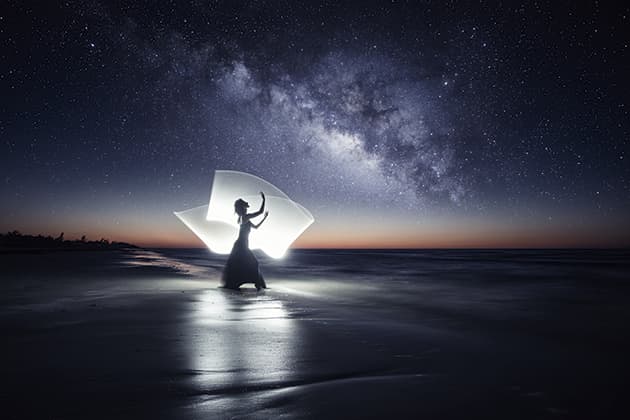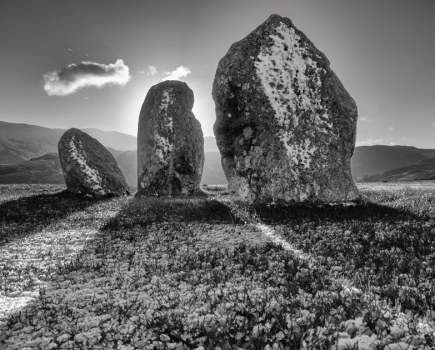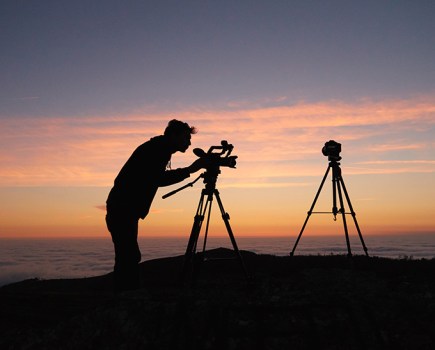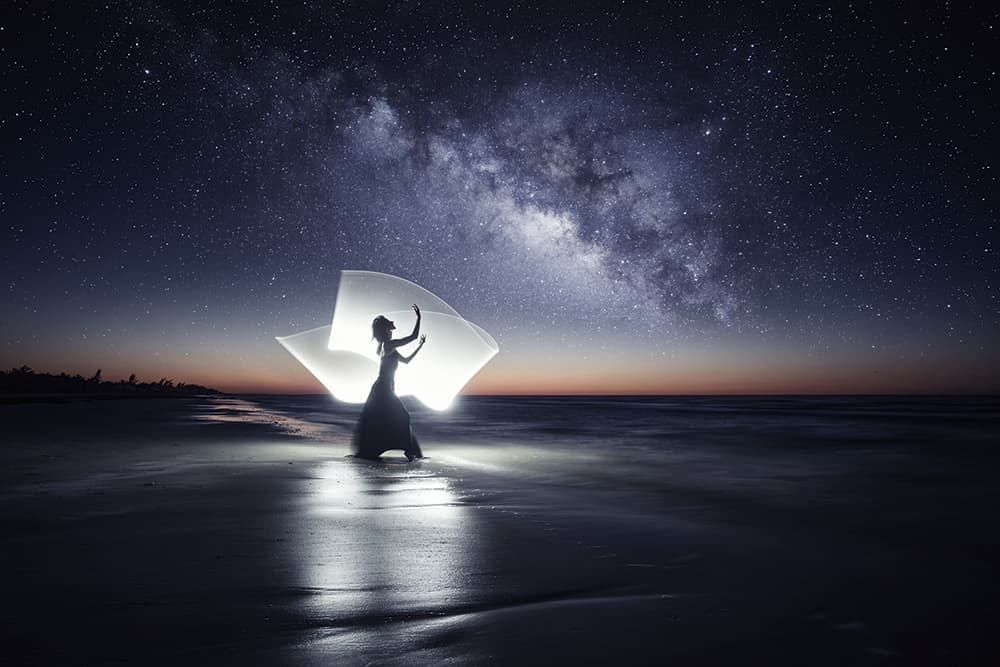
Signs of Light. Canon EOS 6D, 18mm,1.5secs at f/5.6, ISO 200
Looking through Eric Paré’s portfolio, you can’t help but be struck by the ethereal landscapes that act as a backdrop to his beautiful light paintings, created in collaboration with Kim Henry, a dancer who usually appears in his photographs. Speaking to Eric, it’s clear to see that his enthusiasm for the subject matter not only stretches to creating new images, but also helps others achieve the same look.
Eric is a French-Canadian photographer from a small city near Montreal. Having travelled extensively, including a stint living in Paris, he now has a studio on the Plateau, a place he describes as ‘the best place to live in Montreal.’
He first started experimenting with light paintings a few years ago, a technique that took him some time to hone the skills of, as he explains: ‘I learned mostly by trial and error in a very complicated environment. My first six months of experimentations were in a tiny 360° studio using 24 cameras. My goal was to properly light my subjects without revealing the surrounding cameras. Light painting was the obvious choice as the light is very concentrated on the subject. However, using light painting means long exposures, and most of the time, blurry pictures. Over a few weeks, my average exposure duration went from 60secs to 1sec, which I achieved by improving my movements and increasing the power of my lights. This is where I felt I really had something. I’ve been doing 1sec light painting since then.’
Eric’s collaboration with Kim Henry started during the early days of his light-painting projects. He says: ‘She’s been part of all my recent adventures, including the workshops, performances, conferences, camel rides and food orgies.’
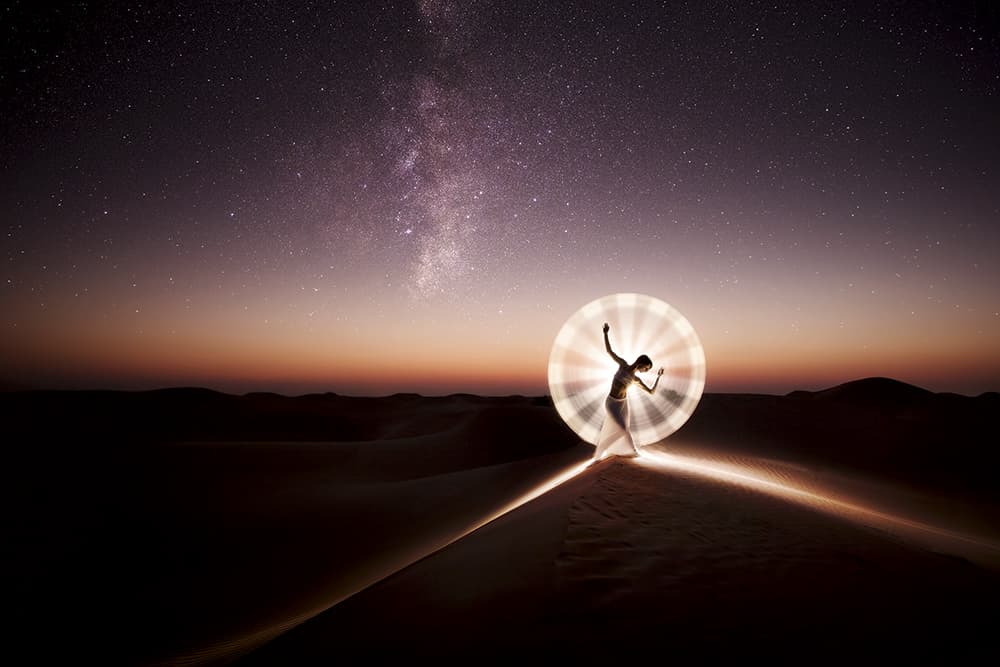
Signs of Light. Canon EOS 5D Mark III, 18mm, 1.4secs at f/5.6, ISO 400
The tools for the job
Eric has an extremely extensive set of cameras and has been a Canon user for more than 10 years. ‘I own 55 cameras and 120 lenses,’ he says. ‘For my 360° work, I use the Canon EOS 100D, which is the smallest DSLR on the market. However, when I travel, my kit is a pair of EOS 6Ds combined with 14mm and the 35mm lenses. I always shoot with the two cameras side by side, giving very different results because of the focal length. I also use a small Canon PowerShot to film the scene.’
Although you might expect the equipment he uses to create the light trails to be quite complex, it is in fact extraordinarily simple, with Eric often relying on ordinary household items. ‘I use anything I can find, including plumbing stuff, papers, Plexiglass and toys,’ says Eric. ‘But for the past year, I’ve been using mostly a 4ft [1.2m] plastic tube in which I insert a flashlight/torch.’
The techniques Eric employs to get the shots are also relatively straightforward. ‘Camera settings are nearly always the same when I do light painting,’ he explains. ‘I use ISO 400, f/5.6 and bulb mode. Bulb mode is very important in my case because I want to decide the [precise] exposure duration for each picture. That means I have a remote control in my hand, and I hold down the trigger button for about 1sec when taking the picture.
‘The photo ‘Signs of Light’ is a typical example of my work. To achieve this look I stand behind Kim and quickly draw the shape of light from top to bottom. I was able to capture a perfect circle by hand. I started the movement exactly behind one of Kim’s legs to avoid the overlap in the circle. The stripe effect is achieved by using two flashlights and setting one of the two in strobe mode.’
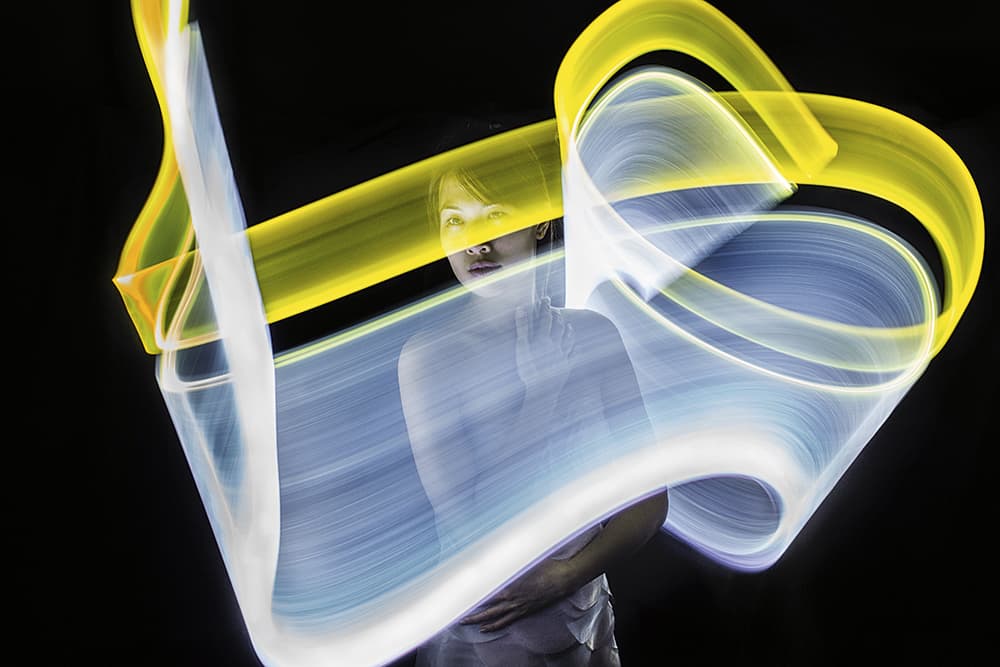
Ribbon Light Painting. Canon EOS 5D Mark III, 40mm, 1.3secs at f/5.6, ISO 800
The locations
Over the two years that Eric and Kim have been working together, they have travelled to some ideal locations for this type of work. Some places naturally lend themselves to the shots that Eric creates. ‘Our ideal is to find empty spaces like deserts, beaches, lakes and fields,’ he says. ‘So far we have been lucky enough to shoot in Dubai, Utah, California and Mexico. We love reflections created at night using our lights… if you see some blinking lights far away, feel free to come and say hi!’
The routine of finding good locations and the actual shoot itself is a fun process for Eric. ‘We do location scouting during the day, trying to find where the sun is going to go down,’ he says. ‘Then, we take it slowly until the blue hour comes: we do some yoga, I watch Kim dancing, we eat and plan the shots. When the sun goes below the horizon, everything is set up and we’re ready to start. This goes fast and we enter into a kind of trance that lasts about 15 minutes. That is the time we have where the background is still visible and my light painting is effective.’
Eric and Kim have to work fast, having only a few minutes to get the shots at the right time. ‘We have such a short window of time to get the optimal results and this is always the peak of the day, the special moment we’ve been waiting for,’ he continues. ‘I compare this to when I was a kid and it was fireworks day. There’s a huge build up during the day, knowing there is that special event at night. Then it begins, it doesn’t last very long, but it surely stays the highlight of the day.’
The duo has some lofty ambitions for further locations to create their images. ‘We’ve been scratching our heads recently with the idea of shooting on the moon. Of course, it will never happen, but dreaming is free…’ If space tourism doesn’t take off in the near future, Eric has some other ideas that are (relatively) closer to home, albeit almost as remote. ‘On a more serious note, we’d like to give it a shot in Antarctica, where we’re sure to find our usual feeling of infinity and emptiness.’
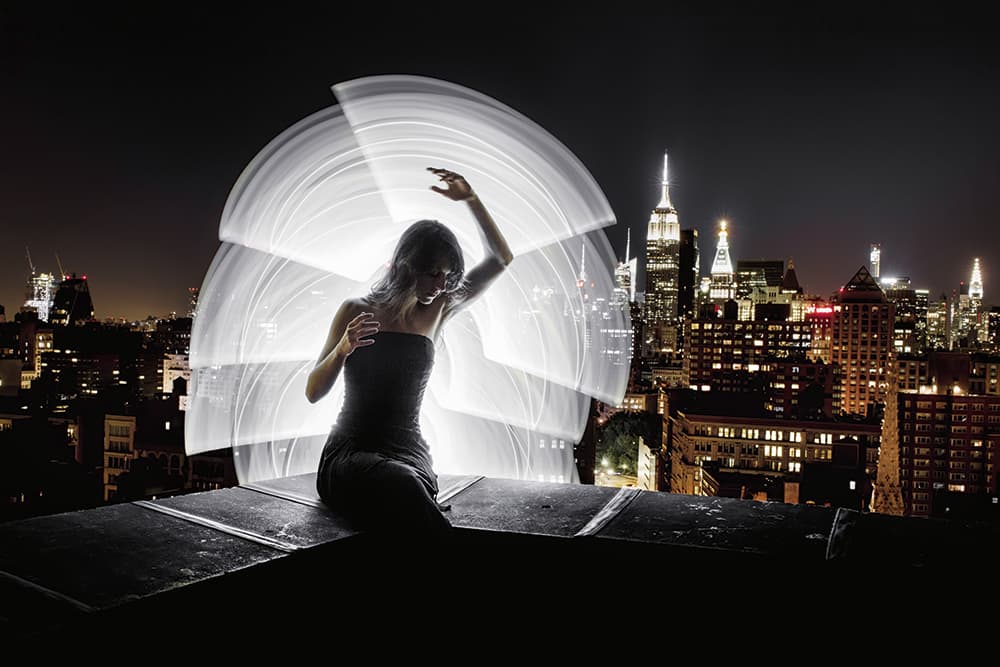
Light Painting in NYC. Canon EOS 6D, 35mm, 5secs at f/10, ISO 800
Passing on the knowledge
Over the years, Eric and Kim have curated and led workshops to help students learn more about his light-painting techniques, and it’s clear how much his passion and patience for the subject could be inspiring to others wanting to recreate the look. Unfortunately, a busy calendar isn’t conducive to as many workshops as perhaps Eric would like at the moment.
‘We did a lot of workshops last year, but our schedule does not allow us to do much now,’ he says. ‘However, we’re running a learning group on Facebook that’s starting to become quite popular, with more than 4,000 members so far.’ Eric is thrilled by how other photographers have responded to his techniques and tutorials: ‘We’ve seen over 200 pictures of folks experimenting with the light-tube so far! How amazing!’
Some exciting opportunities have presented themselves to the duo thanks to the recognition of the light paintings. ‘We were invited by Adobe not long ago to do real-time 360° light painting at Adobe MAX [creativity conference],’ explains Eric. ‘We shot about 1,000 people in three days, creating more than 3,000 pictures. We are conscious that we’re lucky to have opportunities like this one and hope to develop this even further with some new concepts we’ve been developing in the studio recently. Also, our projects get us to be invited by various festivals and shows to perform our [technique] and speak about [our] experience.’
For the moment, Eric is more than happy to continue to work on his light-paintings projects, but is developing new techniques all the time. ‘We continue to travel with the tubes, as it’s probably the best thing I can imagine for the moment,’ says Eric, ‘But on top of that many new things have been developed in the studio recently where you can clearly still see the similarities with my style, but the light is not made by hand.’
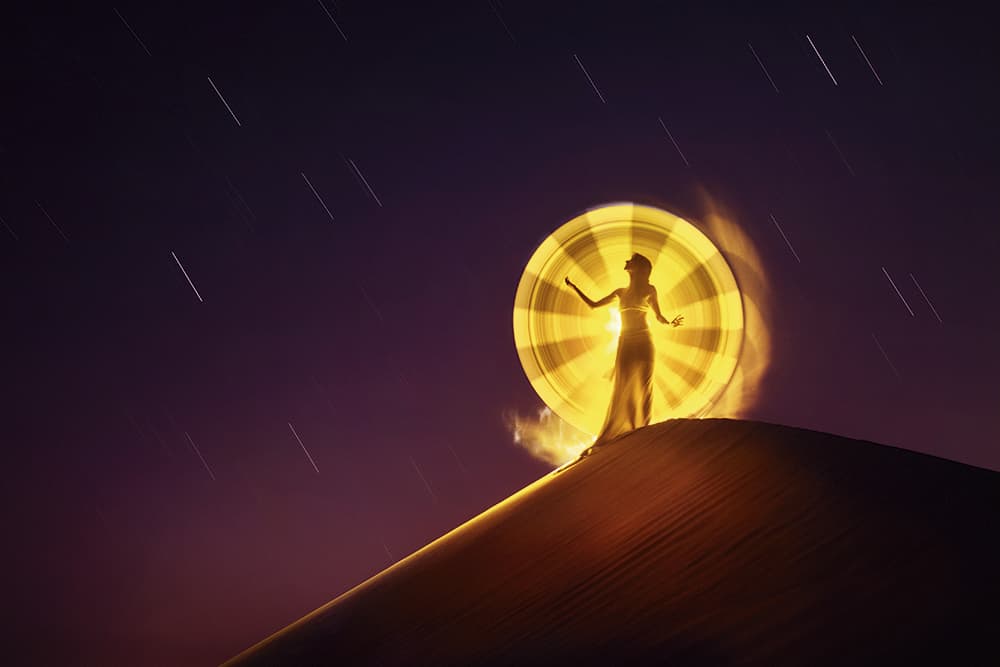
Lighting up the Desert, Eric Pare
Getting the shots
The biggest setback Eric and Kim face in creating these images is, unsurprisingly, the weather. ‘Dealing with outdoor conditions is quite challenging and can ruin a night’s shooting,’ says Eric. ‘but most of the time we manage to get what we’re looking for, despite the wind or the cold.’
Although creating the light trails takes only a second, many of Eric’s final images are merged to include star trails and create a whole scene. This takes place after the main subject of the shoot is captured. ‘My favourite post- processing is to include star trails that we shoot when we’re done with light painting,’ says Eric. ‘We do this by taking a 30-minute-exposure picture. it’s very important to keep the camera in the same place to simplify the editing’.
In the above image, called ‘Lighting Up the Desert’, we can see the combination of light painting and star trails – and it’s one of Eric’s most popular pictures. ‘it was such a fun image to create,’ he says. ‘To get the fluffy things outside the circle, I filled my tube with sand prior to starting the movement. The end result is magical, but we ended up having sand everywhere up to our ears!’
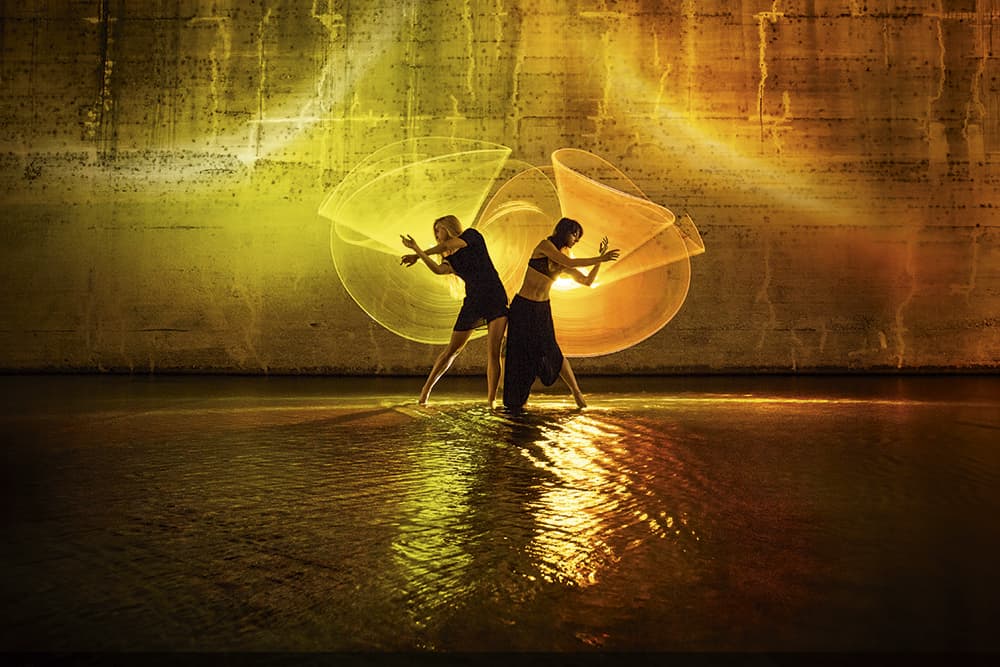
Light-painting Under the Bridge. Canon EOS 5D Mark III, 18mm, 2secs at f/4.5, ISO 1,600
Light-painting accessories
Why not give it a go yourself with these handy light-painting accessories?
Pixelstick
Price: $349 (£261)
Website: www.thepixelstick.com
The programmable Pixelstick comes ready with a dozen different patterns, but you can create your own for infinite different effects with colours, patterns, letters and more.
Light Painting Brushes Deluxe Starter Kit
Price: $189 (£141)
Website: www.lightpaintingbrushes.com
This has a variety of tools all in one box, including a ‘collapsible light sword’ available in different colours.
Tube Guard
Price: Prices vary depending on brand
Website: www.amazon.co.uk
Take the lo-fi approach just like Eric with tube guards, which can be picked up very cheaply – they’re designed for fluorescent lights. To use them for light painting, place a torch inside them, and you’ll get different looks depending on the brightness of the torch.
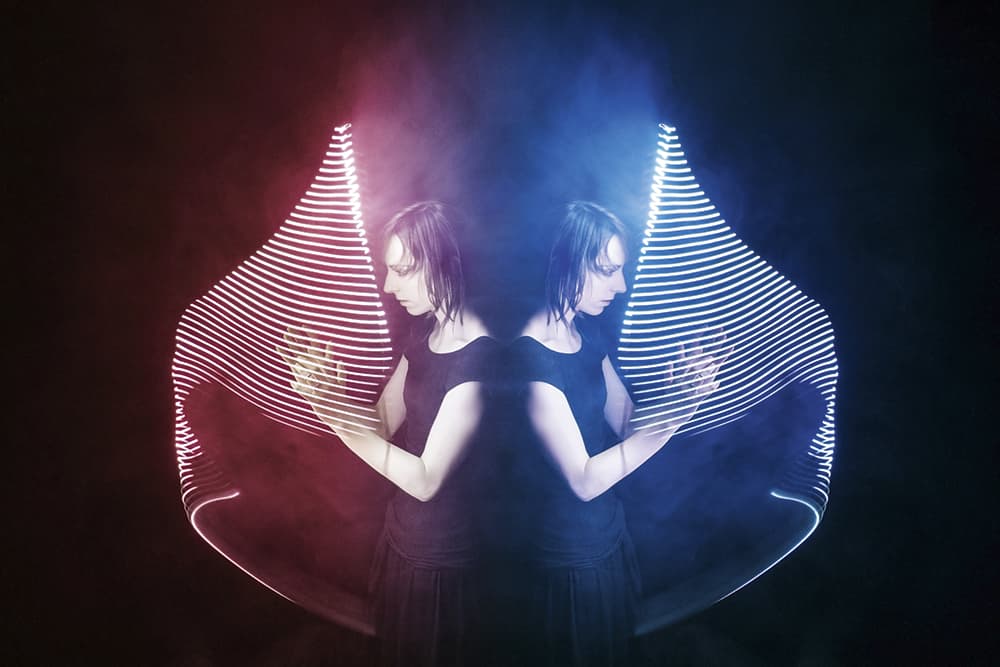
The Floating Harp. Canon EOS 100D, 18-55mm, 0.3sec at f/9, ISO 1,600
Eric Paré is a Canadian artist who has been producing light-painting images since 2013. His work has appeared on CNN, MTV, PetaPixel, Tech Insider and TEDxMontreal. He has hosted a series of talks and workshops across the world. To find out more, visit www.ericpare.com. Follow Eric and Kim’s work on 500px.com and learn more about his technique on his website or his Facebook group.

